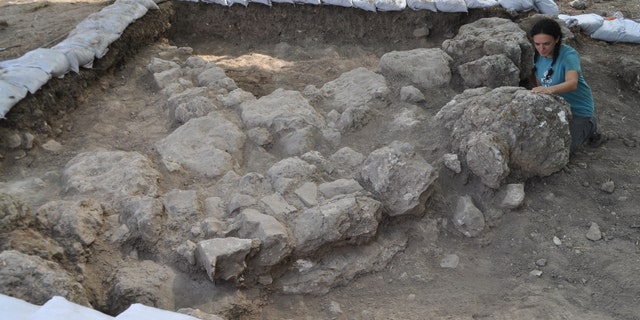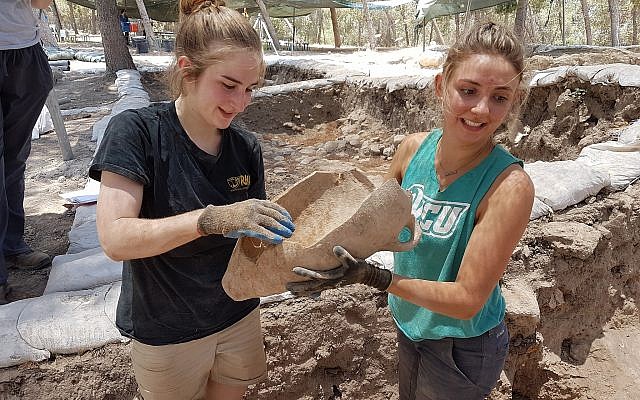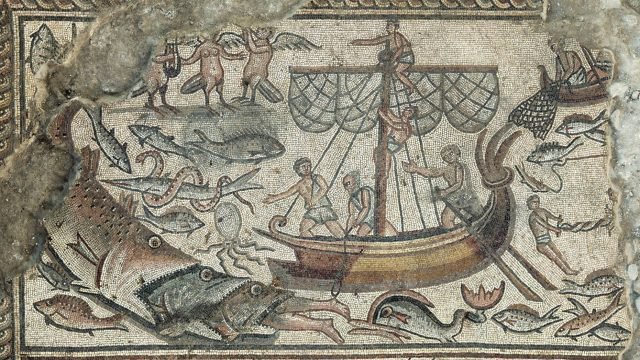Israel
Archaeological evidence verifies long-doubted medieval accounts of First Crusade
Jonathan KantrowitzatArchaeology News Report - 1 week ago

[image:
IMAGE] *IMAGE: *This earpiece, perhaps of Egyptian manufacture, is
apparent loot from the First Crusade sack of Jerusalem in July, 1099.
view more Credit: Virginia Withers The University of North Carolina at
Charlotte-led archaeological dig on Jerusalem's Mount Zion has been
going on for over a decade, looking at an area where there were no known
ruins of major temples, churches or palaces, but nonetheless sacred
land where three millennia of struggle and culture has long lain buried,
evidence in layer upon layer of significant historical events.
Virtually every dig season,... more »
Largest Neolithic Settlement in Israel: Up to 3,000 People May Have Lived There
Jonathan KantrowitzatArchaeology News Report - 2 weeks ago
Complete
article Archaeologists have known about this location, called the Motza
site, for decades. However, now that the government plans to build a
new highway entrance and new roundabouts there, the Israel Antiquities
Authority sent a team to do a full-scale excavation of the Neolithic
settlement, Vardi told Live Science. This effort quickly became the
largest excavation of a Neolithic site in the country, he said. During
the Neolithic, hunter-gatherer groups began farming and making permanent
settlements. So, it came as no surprise when they found large buildings
with rooms wh... more »
Ancient genomics pinpoint origin and rapid turnover of cattle in the Fertile Crescent
Jonathan KantrowitzatArchaeology News Report - 3 weeks ago

[image:
IMAGE] *IMAGE: *A zebu-shaped weight from Tel Beth-Shemesh. view more
Credit: A. Hay, courtesy of the Tel Beth-Shemesh Excavations exhibition.
The keeping of livestock began in the Ancient Near East and underpinned
the emergence of complex economies and then cities. Subsequently, it is
there that the world's first empires rose and fell. Now, ancient DNA
has revealed how the prehistory of the region's largest domestic animal,
the cow, chimes with these events. An international team of
geneticists, led by those from Trinity College Dublin, have deciphered
early bovine prehistor... more »
Jonathan KantrowitzatArchaeology News Report - 3 weeks ago

Archaeologists
in southern Israel have discovered an ancient biblical city from the
time of King David. The site was discovered near the modern city of
Kiryat Gat by researchers from the Hebrew University in Jerusalem,
Macquarie University in Australia and the Israel Antiquities Authority.
The Philistine ancient city of Ziklag is mentioned multiple times in the
Bible in relation to David, the researchers note, citing 1 Samuel and 2
Samuel. “According to the Biblical narrative, Achish, King of Gat,
allowed David to find refuge in Ziklag while fleeing King Saul and from
there David al... more »
Archaeologists say they found town where future King David took refuge from Saul
Jonathan KantrowitzatArchaeology News Report - 3 weeks ago

home
page Complete article Carbon 14 dating supports the archaeologists'
identification For decades scholars sought the elusive site of Ziklag,
where the Bible says David was given shelter by Philistine King Achish
[image: Volunteers excavate pottery from Khirbet a-Ra'i, which
archaeologists have identified as biblical Ziklag. (Excavation
expedition to Khirbet a-Ra‘i)] Volunteers excavate pottery from Khirbet
a-Ra'i, which archaeologists have identified as biblical Ziklag.
(Excavation expedition to Khirbet a-Ra‘i) In a finding sure to inflame
the debate about the historicity of th... more »
More on 1,600-yr-old Biblical Mosaics Found in Ancient Galilean Village
Jonathan KantrowitzatArchaeology News Report - 3 weeks ago

Complete
article *Full mosaic depicting Jonah being swallowed by a giant fish in
the ancient Huqoq synagogue. * In an excavation led by Professor Jodi
Magness of the University of North Carolina at Chapel Hill, a
1,600-year-old biblical triptych of mosaics made of small stone cubes
(or tesserae) was found in a synagogue in the ancient Galilean village
of Huqoq in Israel. “We’ve uncovered the first depiction of the episode
of Elim ever found in ancient Jewish art,” said Dr. Magness. This comes
on the heels of earlier mosaic discoveries at this site which include
depictions of The To... more »
Ancient DNA sheds light on the origins of the Biblical Philistines
Jonathan KantrowitzatArchaeology News Report - 4 weeks ago
An
international team, led by scientists from the Max Planck Institute for
the Science of Human History and the Leon Levy Expedition, retrieved
and analyzed, for the first time, genome-wide data from people who lived
during the Bronze and Iron Age (~3,600-2,800 years ago) in the ancient
port city of Ashkelon, one of the core Philistine cities during the Iron
Age. The team found that a European derived ancestry was introduced in
Ashkelon around the time of the Philistines' estimated arrival,
suggesting that ancestors of the Philistines migrated across the
Mediterranean, reaching Ash... more »
Newly-discovered 1,600-year-old mosaic sheds light on ancient Judaism
Jonathan KantrowitzatArchaeology News Report - 4 weeks ago

Elim
mosaic detail, Huqoq Excavation Project. Copyright Jim Haberman. All
rights reserved. Courtesy: UNC-Chapel Hill. Copyright Jim Haberman *For
nine years running, Carolina professor Jodi Magness has led a team of
research specialists and students to the ancient village of Huqoq in
Israel's Lower Galilee, where they bring to light the remains of a Late
Roman synagogue. For weeks during the summer, they unearth history in
the form of art. With each excavation season, the students and
researchers build on what little is known about the fifth century CE
Jewish community of H... more »
Americas
Human genetic diversity of South America reveals complex history of Amazonia
Jonathan KantrowitzatArchaeology News Report - 12 hours ago

New study explores genetic roots of 26 populations from diverse regions and cultures of western South America and Mexico, revealing long-distance connections between speakers of the same language, and new traces of genetic diversity within Amazonia Max Planck Institute for the Science of Human History [image: IMAGE] *IMAGE: *The vast cultural and linguistic diversity of Latin American countries is still far from being fully represented by genetic surveys. A new study explores the genetic roots of 26 populations... view more Credit: Chiara Barbieri and Rodrigo Barquera The vast cult... more »
White-tailed deer were predominant in pre-Columbian Panama feasts
Jonathan KantrowitzatArchaeology News Report - 1 week ago

Smithsonian Tropical Research Institute [image: IMAGE] *IMAGE: *After analyzing white-deer remains from a site in Panama occupied between 2,200 and 500 years ago, María Fernanda Martínez-Polanco found some evidence of feasting signs.... view more Credit: Smithsonian Tropical Research Institute In pre-Columbian times, the white-tailed deer was among the most abundant and frequently consumed mammals in Panama. It was also an icon, represented on thousands of clay vessels. Through an analysis of deer remains in refuse piles at the Sitio Sierra archaeological site, researchers from the ... more »
Pleistocene/early Holocene Mesoamerican stone tool tradition
Jonathan KantrowitzatArchaeology News Report - 1 week ago

University of New Mexico [image: IMAGE] *IMAGE: *UNM graduate student Paige Lynch conducting excavations at Mayahak Cab Pek in May 2019, part of ongoing UNM research into the earliest humans in the New World tropics. view more Credit: University of New Mexico From the perspective of Central and South America, the peopling of the New World was a complex process lasting thousands of years and involving multiple waves of Pleistocene and early Holocene period immigrants entering into the Neotropics. Paleoindian colonists arrived in waves of immigrants entering the Neotropics, a region ... more »
Food may have been scarce in Chaco Canyon
Jonathan KantrowitzatArchaeology News Report - 3 weeks ago
Chaco Canyon, a site that was once central to the lives of pre-colonial peoples called Anasazi, may not have been able to produce enough food to sustain thousands of residents, according to new research. The results could shed doubt on estimates of how many people were able to live in the region year-round. Located in Chaco Culture National Historic Park in New Mexico, Chaco Canyon hosts numerous small dwellings and a handful of multi-story buildings known as great houses. Based on these structures, researchers think that it was once a bustling metropolis that was home to as many a... more »
Maize-centric diet may have contributed to ancient Maya collapse
Jonathan KantrowitzatArchaeology News Report - 4 weeks ago
The question of how to best adapt to extreme climate is a critical issue facing modern societies worldwide. In "The Role of Diet in Resilience and Vulnerability to Climate Change among Early Agricultural Communities in the Maya Lowlands," published in *Current Anthropology*, authors Claire Ebert, Julie Hoggarth, Jaime Awe, Brendan Culleton, and Douglas Kennett examine the role of diet in the ability of the ancient Maya to withstand periods of severe climatic stress. The authors found that an increase in the elite Maya's preference for a maize-based diet may have made the population... more »
Europe
Stone tool changes may show how Mesolithic hunter-gatherers responded to changing climate
Jonathan KantrowitzatArchaeology News Report - 2 weeks ago

[image: IMAGE] *IMAGE: *Reconstruction of a Mesolithic camp-site with a hunter in the front ready to fire an arrow mounted with stone microliths. view more Credit: Ulco Glimmerveen The development of new hunting projectiles by European hunter-gatherers during the Mesolithic may have been linked to territoriality in a rapidly-changing climate, according to a study published July 17, 2019 in the open-access journal *PLOS ONE* by Philippe Crombé from Ghent University, Belgium. As a result of warming occurring at a rate of ca. 1.5 to 2°C per century, hunter-gatherers in Europe during t... more »
Ancient Roman port history unveiled
Jonathan KantrowitzatArchaeology News Report - 2 weeks ago
Researchers successfully reconstructed anthropic influences on sedimentation, including dredging and canal gates use, in the ancient harbour of Portus - a complex of harbour basins and canals that formed the hub of commerce in the capital of the Roman Empire. The findings suggest that the Romans were proactively managing their river systems from earlier than previously thought - as early as the 2nd century AD. The history was reconstructed using a range of high-resolution sediment analysis including piston coring, x-ray scanning, radiocarbon dating, magnetic and physical properties... more »
Murder in the Paleolithic? Evidence of violence behind human skull remains
Jonathan KantrowitzatArchaeology News Report - 4 weeks ago

[image: IMAGE] *IMAGE: *Right lateral view of the *Cioclovina calvaria* exhibiting a large depressed fracture. view more Credit: Kranoti *et al*, 2019 New analysis of the fossilized skull of an Upper Paleolithic man suggests that he died a violent death, according to a study published July 3, 2019 in the open-access journal *PLOS ONE* by an international team from Greece, Romania and Germany led by the Eberhard Karls Universität Tübingen, Germany The fossilized skull of a Paleolithic adult man, known as the Cioclovina calvaria, was originally uncovered in a cave in South Transylvania... more »
Africa
Maternal secrets of our earliest ancestors unlocked
Jonathan KantrowitzatArchaeology News Report - 2 weeks ago

Monash University [image: IMAGE] *IMAGE: *Australopithecus africanus impression by Jose Garcia and Renaud Joannes-Boyau, Southern Cross University. view more Credit: Jose Garcia and Renaud Joannes-Boyau, Southern Cross University. - New research brings to light for the first time the evolution of maternal roles and parenting responsibilities in one of our oldest evolutionary ancestors - *Australopithecus africanus* mothers breastfed their infants for the first 12 months after birth, and continued to supplement their diets with breastmilk during periods of food... more »
Out of Africa and into an archaic human melting pot
Jonathan KantrowitzatArchaeology News Report - 2 weeks ago
Genetic analysis has revealed that the ancestors of modern humans interbred with at least five different archaic human groups as they moved out of Africa and across Eurasia. While two of the archaic groups are currently known - the Neandertals and their sister group the Denisovans from Asia ¬- the others remain unnamed and have only been detected as traces of DNA surviving in different modern populations. Island Southeast Asia appears to have been a particular hotbed of diversity. Published in the *Proceedings of the National Academy of Sciences (PNAS)*, researchers from the Univers... more »
Neanderthals/ Densiovans
Ancient molar points to interbreeding between archaic humans and Homo sapiens in Asia
Jonathan KantrowitzatArchaeology News Report - 3 weeks ago

[image: IMAGE] *IMAGE: *The three-rooted lower molar anomaly in a recent Asian individual. Left: tooth sockets showing position of accessory root; right: three-rooted lower first molar tooth. view more Credit: Christine Lee An analysis of a 160,000-year-old archaic human molar fossil discovered in China offers the first morphological evidence of interbreeding between archaic humans and *Homo sapiens* in Asia. The study, which appears in the journal *Proceedings of the National Academy of Sciences*, centers on a three-rooted lower molar--a rare trait primarily found in modern Asians-... more »
Neanderthals used resin 'glue' to craft their stone tools
Jonathan KantrowitzatArchaeology News Report - 4 weeks ago
------------------------------ Archaeologists working in two Italian caves have discovered some of the earliest known examples of ancient humans using an adhesive on their stone tools -- an important technological advance called "hafting." The new study, which included CU Boulder's Paola Villa, shows that Neanderthals living in Europe from about 55 to 40 thousand years ago traveled away from their caves to collect resin from pine trees. They then used that sticky substance to glue stone tools to handles made out of wood or bone. The findings add to a growing body of evidence that sug... more »
Asia
Jonathan KantrowitzatArchaeology News Report - 3 weeks ago

[image: IMAGE] *IMAGE: *The three-rooted lower molar anomaly in a recent Asian individual. Left: tooth sockets showing position of accessory root; right: three-rooted lower first molar tooth. view more Credit: Christine Lee An analysis of a 160,000-year-old archaic human molar fossil discovered in China offers the first morphological evidence of interbreeding between archaic humans and *Homo sapiens* in Asia. The study, which appears in the journal *Proceedings of the National Academy of Sciences*, centers on a three-rooted lower molar--a rare trait primarily found in modern Asians-... more »
Millet farmers adopted barley agriculture and permanently settled the Tibetan Plateaus
Jonathan KantrowitzatArchaeology News Report - 4 weeks ago
The permanent human occupation on the Tibetan Plateau was facilitated by the introduction of cold-tolerant barley around 3600 years before present (BP), however, how barley agriculture spread onto the Tibetan Plateau remains unknown. Now by using both genetics and archaeological data, researchers from Kunming Institute of Zoology, CAS and Lanzhou University revealed that the barley agriculture was mainly brought onto the plateau by the millet farmers from northern China. Moreover, the genetic contribution from millet farmers largely promoted the formation of genetic landscape of th... more »
No comments:
Post a Comment